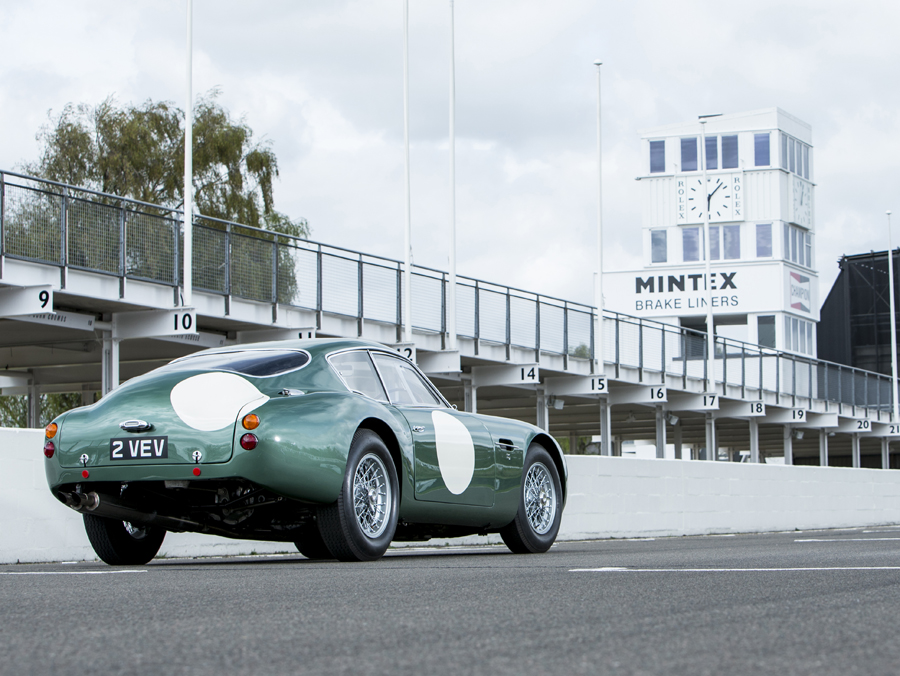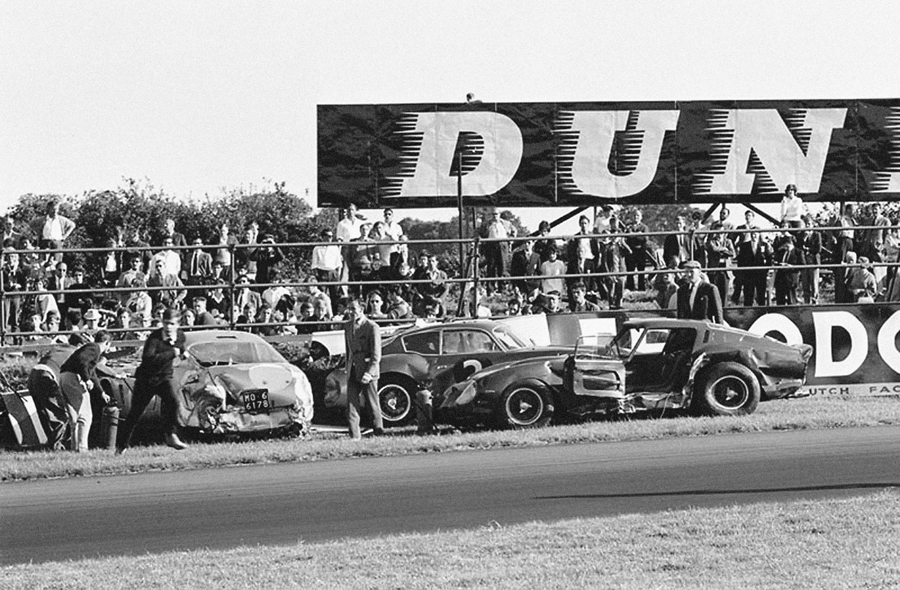SCM Analysis
Detailing
| Vehicle: | 1961 Aston Martin DB4GT Zagato “2 VEV” |
| Years Produced: | 1961–62 |
| Number Produced: | 19 |
| Original List Price: | $12,000 |
| SCM Valuation: | $13,500,000 (this car) |
| Chassis Number Location: | Right front frame rail |
| Engine Number Location: | Left front of block |
| Club Info: | Aston Martin Owners Club |
| Website: | http://amoc.org |
| Alternatives: | 1960–63 Ferrari 250 SWB, 1961 Jaguar “Lightweight” E-type, 1961 Porsche Abarth 356B Carrera |
| Investment Grade: | A |
This car, Lot 335, sold for $13,264,955, including buyer’s premium, at Bonhams’ Goodwood Festival of Speed auction on July 13, 2018.
There are certain racing cars (mostly British) that have become so famous, so iconic, that they have been identified all their lives by their registration numbers, and “2 VEV” is the classic example.
Only the most severe Aston anorak would know the actual chassis number, but anyone with even passing knowledge of the GT wars of the early 1960s will instantly recognize “2 VEV” as the greatest racing Aston DB4GT Zagato. The central irony here is that this most famous and recognizable of all Aston Zagatos is quite a way short of being the most valuable, and herein, as they say, lies the tale.
In the beginning…
First, some background. Industrialist David Brown bought Aston Martin more or less as a lark in 1947 and created a lightweight, racing-oriented 2-seat coupe called the DB2. It was successful from the start, but the realities of the business forced Aston to accept the fact that their customers wanted luxury over competition. So the DB2/4 got larger and heavier as an elegant 2+2 GT. By 1956 the DB2/4 was showing its age and it was time for a replacement.
The new DB4 (the DB3 had been a sports-racing variant of the DB2) would need to compete with road GTs from Jaguar and Ferrari. Aston Martin needed to sell it to real customers, so it was conceived as a high-performance 2+2 — not a competition-oriented car.
Light weight and performance were still essential, so the new 3.7-liter 6 had an aluminum block and head, and the bodywork was aluminum.
And the new car needed Italian style.
One five-inch section
Carrozzia Touring in Italy was hired to design and build the bodywork, which was then shipped to Aston for assembly in the U.K. It was an elegant 2+2 design, but through serendipity or forethought, there was a five-inch section in the middle of the body where all the lines were effectively parallel. This allowed the car to be shortened into a 2-seat GT with little expense. You just removed a section in the middle of the body to create a short, light version.
Work on developing the DB4GT started more or less with the introduction of the DB4, and the first example debuted at Silverstone in May of 1959, with Stirling Moss winning easily.
As well as taking five inches out of the wheelbase, they managed to drop 185 pounds of weight and add substantial horsepower through higher compression, Weber carburetors and a twin-plug cylinder head. The GT was still a comfortable road car — not a pure racer. For the factory-associated racing teams, they managed to lose another 150 pounds to create a few “lightweight” racing specials.
Enter Zagato
As wonderful as the DB4GT was, it was still too heavy, too tall, and had too much frontal area to really compete with Ferrari’s 250 SWB.
Aston officially quit racing after winning the 1959 championship, but they remained committed to giving racing clients the most competitive mounts possible.
Thus, in October 1959, Aston approached the Zagato coachbuilding firm about creating a truly lightweight and effective body for the DB4GT chassis.
Zagato’s mantra was to wrap a chassis in as little metal as possible, with weight and frontal area the primary criteria. They didn’t use formal aerodynamics, sticking to the classic Italian formula that “if it looks good, it will work well.”
So beauty came first.
Zagato contracted to build 20 bodies for the DB4GT, and the first was delivered in the fall of 1961. In standard trim it weighed 2,800 pounds — 150 pounds less than a standard GT. The legend was born.
They were fabulous cars, but still more road car than racer. With too much weight on the front tires, the only way to go really fast was to fling the car into the corners, which made for great photos but not competitive lap times.
In a final attempt to be more competitive, Aston created the “MP 209” variant: Three of the 20 Zagatos were given a revised, lighter chassis structure, a lower, flatter, longer nose, higher haunches and a 3.8-liter magnesium-block engine. It was in turn 150 pounds lighter than a standard Zagato.
Our subject car started out as a lightweight Zagato but became an MP 209. Have you been taking notes? Good.
Our subject car
Although officially out of the racing business, Aston maintained very close relations with several private (technically) racing teams.
Essex Racing Stables was the closest to the factory, with Jim Clark, Innes Ireland and Roy Salvadori as drivers. Essex got two of the first “Lightweight” DB4GTs and did well, so when the new Zagatos became available, Essex was first in line. Their cars were registered as “1 VEV” and “2 VEV” respectively, the second being our subject car.
“2 VEV” (chassis 183R) started its career at Le Mans in 1961, where it broke, but it had an impressive rest of the season, primarily at the hands of Jim Clark.
In May of 1962, Aston asked to borrow it for a different team to drive at Spa, where Lucien Bianchi crashed it heavily. It was returned to Aston, who, rather than fixing it, slipped its original chassis number and registration onto the third super-lightweight MP 209 car that was sitting at the factory. Aston then cut up what was left of the old chassis 183R, reducing the original 20 Zagato chassis extant to 19.
The new “2 VEV” resumed racing and immediately broke the magnesium block. An aluminum-block engine was installed in time for Goodwood, but Jim Clark crashed the car. Another Ferrari then hit the car when it was stuck beside the track. Fixed again, it blew an engine at the next race and was retired from competition.
Although it was a short racing career, “2 VEV” had an extraordinary history on the track, and it was arguably the best known of all Aston Zagatos.
“2 VEV” remained a very special car through the following years, with a succession of doting owners as well as active racing and road use. But the car was not exempt from the depredations of time and hard use. A brutal road crash in 1993 cost over £100,000 to repair. Somewhere along the way, the car ended up with a non-original block and head (from a Project 214 Aston, which is cool, but not original).
A chipped jewel
So why wouldn’t this most iconic of Aston Zagatos be among the most valuable?
I will argue that despite racing being the official intent of the cars, they are now primarily collected as art and investment assets. As such, originality, purity and perceived beauty are considered more important than a heroic history.
Although this car is definitely a crown jewel, it has lots of chipped facets compared to one with admittedly fewer stories to tell — but with an unblemished provenance.
Another factor may be its appearance as an MP 209 car. These cars got a different, longer and flatter nose, which means that they don’t look quite like what people think an Aston Zagato should look like. It’s perfect — but still somehow not quite right — and if you are buying art, that can matter.
A sales price of more than $13 million may seem like a ton to most of us, but other GT Zagatos have sold for substantially more.
Rumor had the expectations at top money for this one. The crown-jewel marketplace seems to remain very strong, so I doubt it was a lack of buyers. In this circumstance, it appears that being legendary did not translate to having ultimate value, as the top collectors apparently consider purity more important.
I would say this car was fairly bought and sold. ♦
(Introductory description courtesy of Bonhams.)


